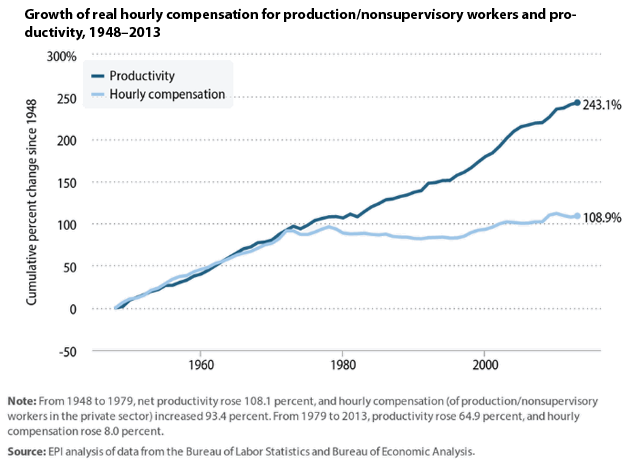An official website of the United States government
 United States Department of Labor
United States Department of Labor
As reported by the Bureau of Labor Statistics, we are currently enjoying the longest run of private sector job growth on record―64 consecutive months to the tune of 12.8 million new private sector jobs overall. We’ve come a long way since late 2008 and early 2009 when the economy, on the brink of meltdown, was shedding hundreds of thousands of jobs each month.
The resilience of American workers―together with the ingenuity of our businesses and leadership from the Obama administration―pulled us out of the worst economic crisis of our lifetimes. And I have every confidence that our workers, ever innovative and industrious, will continue to be our most valuable economic asset a quarter century from now.
But still we face lingering and looming challenges. For about the first 25 years of the post-World War II era, wages rose more or less in line with productivity. But from 1973 to 2013, productivity has continued to soar (an increase of 74.4 percent), while hourly compensation for the typical worker has virtually flattened (up only 9.2 percent). Over the last four decades, workers have not received their fair share of the value they have helped create. They are serving the economy better than the economy is serving them.

But this isn’t an immutable fact of 21st century economic life. Some have elected to throw up their hands and say that technology and globalization have changed the rules of the game and there’s little we can do about it. I reject that fatalism. Yes, we face dramatic changes; but we can adapt to them successfully by making smart choices. Through better policymaking, we can reverse the decline in worker bargaining power and the erosion of labor standards that has put downward pressure on wages.
It starts with raising the national minimum wage, which has been frozen at $7.25 per hour for going on six years now. The Obama Administration supports a bill that will gradually lift the wage floor to $12 per hour by 2020 and update it every year so that its value holds even as the cost of living rises. Using our rulemaking authority, the Labor Department is also revising an overtime regulation that has kept up neither with inflation nor with changes in the economy.1
The labor movement has historically been one of our most powerful forces for economic security and upward mobility, catapulting generations of Americans into the middle class. But shrinking union density―caused in no small part by outdated laws and recent rollbacks in labor protections that make organizing all too difficult―has contributed to the wage stagnation of the last few decades. So, we must continue to be unwavering in support of collective bargaining rights, at the same time that we promote new organizing models and new strategies for amplifying worker voice.
Meeting the wage challenge also requires an understanding of fundamental changes in the nature of work itself. The clear lines and predictability of the traditional employer-employee relationship have been increasingly supplanted by the use of independent contractors, temporary workers and day laborers. More and more, we have what many people have called a “gig economy”―with the looseness of a musician’s one-night engagement at a club now defining in many cases everything from construction and retail work to adjunct professorships at prestigious universities.
Subcontracting and third-party management have created greater degrees of separation between workers and their ultimate employers. For far too many people, this “fissured workplace,” in the words of Wage and Hour Administrator David Weil, means lower pay, meager benefits and reduced protections.
At the Labor Department, we are responding to these shifts. We have retooled our wage enforcement mechanisms, building not just a larger investigation force but one that approaches its work strategically, targeting the top of fissured business structures for maximum impact on its network of subcontractors or up and down its supply chain. Our Occupational Safety and Health Administration has launched an initiative that brings stakeholders together to better protect temporary workers, who are at greater risk of injury or illness on the job.
Throughout DOL, we are exploring the changing nature of work. And to do so effectively, we need access to as much meaningful data as possible. To that end, it is critical, for example, that we fund the Contingent Worker and Alternative Work Arrangement supplement to the Current Population Survey, which BLS has not been able to conduct for a decade.
With better data and a clearer understanding of evolving trends, with smart policymaking and the political will to produce real change, we can solve the wage problem. We can give workers a bigger slice of the pie that they helped bake. Twenty-five years from now, it is my hope that we will look back at this time as one where we successfully dedicated ourselves to expanding opportunity, to creating shared prosperity and an economy that works for everyone.
Thomas E. Perez, "Rising to the challenge of a 21st century workforce," Monthly Labor Review, U.S. Bureau of Labor Statistics, July 2015, https://doi.org/10.21916/mlr.2015.22
1 On June 30, 2015, President Obama formally announced a proposed rule that would extend overtime protections to nearly 5 million white collar workers. The proposal would more than double the weekly earnings threshold below which most salaried workers are guaranteed overtime pay.